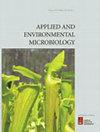n -羟乙胺o-乙酰转移酶在肠杆菌CZ-1菌株4-羟基-3-硝基苯磺酸转化途径中催化3-氨基-4-羟基苯磺酸乙酰化
IF 3.7
2区 生物学
Q2 BIOTECHNOLOGY & APPLIED MICROBIOLOGY
引用次数: 6
摘要
Roxarsone(ROX)是一种有机砷饲料添加剂,70多年来一直广泛应用于家禽行业,用于促进生长、控制球虫病和改善肉类色素沉着。大多数ROX在垃圾中排出并分散到环境中,在那里被微生物转化为不同的含砷化合物。ROX转化的主要产物是N-乙酰基-4-羟基间氨基苯胺酸(N-AHPAA),它也被用作治疗难治性细菌性阴道病的临床药物。在此,我们报道了肠杆菌属菌株CZ-1中编码N-羟基芳基胺O-乙酰转移酶NhoA1和NhoA2的两个基因的克隆和功能表征。该基因催化由ROX还原为N-AHPAA形成的3-氨基-4-羟基苯基胂酸(3-AHPAA)的乙酰化。本研究为N-羟基芳基胺O-乙酰转移酶在一种重要有机砷化合物转化中的作用提供了新的见解。摘要有机砷饲料添加剂4-羟基-3-硝基苯胂酸(roxarsone[ROX])被广泛使用并释放到环境中。我们之前展示了肠杆菌属菌株CZ-1的ROX转化的两步途径,包括将ROX还原为3-氨基-4-羟基苯胂酸(3-AHPAA)和将3-AHPAA乙酰化为N-乙酰基-4-羟基间-乙酰苯胺酸(N-AHPAA,https://doi.org/10.1016/j.envpol.2019.01.076)。在本研究中,我们鉴定了两个nhoA基因(nhoA1和nhoA2),编码N-羟基芳基胺O-乙酰转移酶,负责肠杆菌属菌株CZ-1的3-AHPAA乙酰化。遗传破坏和互补的结果表明,两个nhoA基因都参与了ROX的生物转化,并且nhoA1是主要的3-AHPAA乙酰转移酶基因。定量逆转录PCR分析表明,nhoA1的相对表达水平比nhoA2高3倍。每个重组NhoAs在大肠杆菌BL21中过表达,并通过亲和层析作为二聚体均匀纯化。两种纯化的NhoAs都催化乙酰辅酶A依赖性3-AHPAA乙酰化。3-AHPAA对NhoA1和NhoA2的Km值分别为151.5和428.3μM。定点诱变实验表明,每个NhoA的两个保守的精氨酸和半胱氨酸残基对其酶活性是必需的。IMPORTANCE Roxasone(ROX)是一种有机砷饲料添加剂,70多年来一直被广泛用于家禽行业,用于促进生长、控制球虫病和改善肉类色素沉着。大多数ROX在垃圾中排出并分散到环境中,在那里被微生物转化为不同的含砷化合物。ROX转化的主要产物是N-乙酰基-4-羟基间氨基苯胺酸(N-AHPAA),它也被用作治疗难治性细菌性阴道病的临床药物。在此,我们报道了肠杆菌属菌株CZ-1中编码N-羟基芳基胺O-乙酰转移酶NhoA1和NhoA2的两个基因的克隆和功能表征。该基因催化由ROX还原为N-AHPAA形成的3-氨基-4-羟基苯基胂酸(3-AHPAA)的乙酰化。本研究为N-羟基芳基胺O-乙酰转移酶在一种重要有机砷化合物转化中的作用提供了新的见解。本文章由计算机程序翻译,如有差异,请以英文原文为准。
N-Hydroxyarylamine O-Acetyltransferases Catalyze Acetylation of 3-Amino-4-Hydroxyphenylarsonic Acid in the 4-Hydroxy-3-Nitrobenzenearsonic Acid Transformation Pathway of Enterobacter sp. Strain CZ-1
Roxarsone (ROX) is an organoarsenic feed additive that has been widely used in poultry industries for growth promotion, coccidiosis control, and meat pigmentation improvement for more than 70 years. Most ROX is excreted in the litter and dispersed into the environment, where it is transformed by microbes into different arsenic-containing compounds. A major product of ROX transformation is N-acetyl-4-hydroxy-m-arsanilic acid (N-AHPAA), which is also used as a clinical drug for treating refractory bacterial vaginosis. Here, we report the cloning and functional characterization of two genes encoding N-hydroxyarylamine O-acetyltransferases, NhoA1 and NhoA2, in Enterobacter sp. strain CZ-1, which catalyze the acetylation of 3-amino-4-hydroxyphenylarsonic acid (3-AHPAA) formed by the reduction of ROX to N-AHPAA. This study provides new insights into the function of N-hydroxyarylamine O-acetyltransferase in the transformation of an important organoarsenic compound. ABSTRACT The organoarsenical feed additive 4-hydroxy-3-nitrobenzenearsonic acid (roxarsone [ROX]) is widely used and released into the environment. We previously showed a two-step pathway of ROX transformation by Enterobacter sp. strain CZ-1 involving the reduction of ROX to 3-amino-4-hydroxyphenylarsonic acid (3-AHPAA) and the acetylation of 3-AHPAA to N-acetyl-4-hydroxy-m-arsanilic acid (N-AHPAA) (K. Huang, H. Peng, F. Gao, Q. Liu, et al., Environ Pollut 247:482–487, 2019, https://doi.org/10.1016/j.envpol.2019.01.076). In this study, we identified two nhoA genes (nhoA1 and nhoA2), encoding N-hydroxyarylamine O-acetyltransferases, as responsible for 3-AHPAA acetylation in Enterobacter sp. strain CZ-1. The results of genetic disruption and complementation showed that both nhoA genes are involved in ROX biotransformation and that nhoA1 is the major 3-AHPAA acetyltransferase gene. Quantitative reverse transcription-PCR analysis showed that the relative expression level of nhoA1 was 3-fold higher than that of nhoA2. Each of the recombinant NhoAs was overexpressed in Escherichia coli BL21 and homogenously purified as a dimer by affinity chromatography. Both purified NhoAs catalyzed acetyl coenzyme A-dependent 3-AHPAA acetylation. The Km values of 3-AHPAA for NhoA1 and NhoA2 were 151.5 and 428.3 μM, respectively. Site-directed mutagenesis experiments indicated that two conserved arginine and cysteine residues of each NhoA were necessary for their enzyme activities. IMPORTANCE Roxarsone (ROX) is an organoarsenic feed additive that has been widely used in poultry industries for growth promotion, coccidiosis control, and meat pigmentation improvement for more than 70 years. Most ROX is excreted in the litter and dispersed into the environment, where it is transformed by microbes into different arsenic-containing compounds. A major product of ROX transformation is N-acetyl-4-hydroxy-m-arsanilic acid (N-AHPAA), which is also used as a clinical drug for treating refractory bacterial vaginosis. Here, we report the cloning and functional characterization of two genes encoding N-hydroxyarylamine O-acetyltransferases, NhoA1 and NhoA2, in Enterobacter sp. strain CZ-1, which catalyze the acetylation of 3-amino-4-hydroxyphenylarsonic acid (3-AHPAA) formed by the reduction of ROX to N-AHPAA. This study provides new insights into the function of N-hydroxyarylamine O-acetyltransferase in the transformation of an important organoarsenic compound.
求助全文
通过发布文献求助,成功后即可免费获取论文全文。
去求助
来源期刊

Applied and Environmental Microbiology
生物-生物工程与应用微生物
CiteScore
7.70
自引率
2.30%
发文量
730
审稿时长
1.9 months
期刊介绍:
Applied and Environmental Microbiology (AEM) publishes papers that make significant contributions to (a) applied microbiology, including biotechnology, protein engineering, bioremediation, and food microbiology, (b) microbial ecology, including environmental, organismic, and genomic microbiology, and (c) interdisciplinary microbiology, including invertebrate microbiology, plant microbiology, aquatic microbiology, and geomicrobiology.
 求助内容:
求助内容: 应助结果提醒方式:
应助结果提醒方式:


